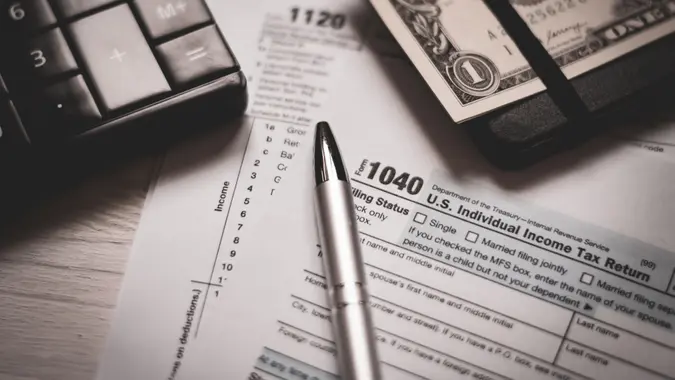Alternative Minimum Tax: How It Works

Commitment to Our Readers
GOBankingRates' editorial team is committed to bringing you unbiased reviews and information. We use data-driven methodologies to evaluate financial products and services - our reviews and ratings are not influenced by advertisers. You can read more about our editorial guidelines and our products and services review methodology.

20 Years
Helping You Live Richer

Reviewed
by Experts

Trusted by
Millions of Readers
America’s income tax policy uses a graduated system designed to ensure that high earners pay a larger percentage of their income than those with lower incomes. However, some high-income taxpayers also have large deductions, so they may have a low average tax rate. The alternative minimum tax exists to fix that.
Here’s everything you need to know.
What Is the Alternative Minimum Tax?
The alternative minimum tax is legislation that ensures a person’s tax obligation does not fall below a certain amount.
In other words, it tries to fill a gap in the tax code. The goal is simple — high-income taxpayers still have to pay a certain amount of tax regardless of deductions.
The AMT mainly affects high-income individuals with various deductions. The following people are most likely to experience an impact from the AMT:
- Taxpayers with high deductions at the state or local level.
- Tech employees with stock options.
- Investors with significant capital gains.
How the Alternative Minimum Tax Works
Taxpayers with significant incomes and many deductions may be subject to the AMT. These taxpayers usually have an unexpectedly low tax burden that doesn’t match their large incomes.
Here are three examples of when AMT kicks in and how it works.
1. Exercising Incentive Stock Options
One of the most common instances of alternative minimum tax is when taxpayers exercise incentive stock options and buy their company’s stock at a discounted price. Regular taxes don’t apply to these purchases, but AMT does.
Example: Employee Stock Purchase
You’re the second employee hired at a new startup, and it becomes hugely successful. Since you got in on the ground floor, you purchased stock at a significant discount compared to the current asking price. AMT will most likely apply.
2. High Capital Gains
If your income exceeds $1 million and includes large capital gains, you might trigger the AMT. Long-term capital gains usually have a 15% to 20% tax rate. But if the gains make up a significant portion of your taxable income, it could trigger the AMT.
Example: Selling a Business With Major Gains
You sold a business you owned for 12 years. During that time, its value increased by nearly 500%. You might have to pay AMT.
3. Uncommon Income Sources
You may be subject to AMT if you have income from certain sources.
Example: Income From Niche Investment Sources
Private activity bonds, intangible drilling costs or accelerated depreciation on leased property could be subject to AMT.
How Do You Calculate the Alternative Minimum Tax?
To calculate the alternative minimum tax, you must first calculate the minimum tax. The AMT is the difference between the tentative minimum tax and the standard income tax.
Here are the steps you can take to calculate the tentative minimum tax:
- Start with your regular income.
- Include deductions not allowed under AMT rules — such as state tax deductions or interest on some bonds.
- Subtract the AMT exemption. This is $88,100 for single filers in 2025.
- Apply the AMT tax rate — 26% or 28% depending on the amount.
Good To Know
Remember, you only need to pay the AMT minimum tax if it’s higher than the tax from your regular tax bracket.
Here’s an example: Say you owe $20,000 in regular taxes. When you calculate the AMT tax rate, you owe $15,000. You would use the regular tax rate and pay $20,000.
You can also use a tax calculator or complete IRS Form 6251 to figure out your AMT.
Income Levels, Thresholds and Triggers for AMT
The easiest way to determine whether AMT applies is to consider your income amount, where it comes from, and how many deductions you use to offset your tax burden.
The alternative minimum tax amounts from 2024 are no longer valid. The following AMT exemption amounts apply in 2025.
| Filing Status | 2025 AMT Exemption |
|---|---|
| Single or head of household | $88,100 |
| Married, filing separately | $68,500 |
| Married, filing jointly | $137,000 |
You don’t have to pay AMT on income below this exemption amount. But you also don’t automatically owe AMT if your income is above the exemption threshold — it depends on whether the AMT is more or less than your regular tax amount.
What Triggers AMT in 2025?
Any taxpayer could be subject to the AMT in 2025. It depends on your income level and deductions. But the following activities are more likely to trigger the AMT:
- State and local tax deductions over $10,000.
- Exercising stock options.
- High passive income.
AMT: Impact on Different Taxpayers
The AMT doesn’t impact most taxpayers. Just because income is above the exemption amount doesn’t necessarily mean you are subject to the alternative minimum tax. It only means that you need to do the calculation to make sure that you’re not. You would need an unusually high amount in deductions to be subject to AMT.
For example, a single filer making $500,000 with $200,000 of deductions is more likely to trigger AMT than someone earning $700,000 without significant deductions.
Pro Tip
Most tax preparation software programs will automatically calculate whether you’re subject to the AMT and alert you if it applies — no extra steps are needed on your part.
Credit for Prior Years
If you paid AMT in previous years but not this one, you can use a tax credit to reduce your taxes this year.
For example, imagine you exercised stock options in 2023 and paid AMT. In 2025, you didn’t trigger AMT, so you might be able to claim some of it as a credit.
To claim this credit, fill out Form 8801, Credit for Prior Year Minimum Tax – Individuals, Estates, and Trusts, and attach it to your Form 1040.
How To Avoid AMT Legally
Even though you can’t avoid AMT altogether, you can take steps to lower the amount you owe.
Here are some common ways to legally reduce the amount you owe:
- Exercise stock options across multiple years.
- Donate stock as a tax write-off.
- Use fewer deductions.
History and Background of the AMT
The original purpose of the AMT was to prevent high-income earners from paying little or no tax due to legal loopholes, and it still applies today.
Here’s how it came to exist:
- In 1969, Treasury Secretary Joseph W. Barr revealed to Congress that 155 taxpayers earning over $200,000 paid no federal income tax in 1966.
- In response, citizens wrote more letters to Congress than they did during the entire Vietnam War.
- Congress then created the “add-on minimum tax.” Households had to pay this in addition to standard income tax to cover capital gains and other types of income taxed lightly or not at all.
- Congress enacted the modern AMT in 1979. It has undergone various revisions since then, but its purpose remains the same.
Will AMT Affect More People in 2026?
The 2017 Tax Cuts and Jobs Act dramatically reduced the number of taxpayers subject to the alternative minimum tax. However, those provisions will sunset at the end of 2025 without Congressional intervention.
If that happens, the number of taxpayers affected by the provision will jump from just a few thousand to approximately 6.7 million.
FAQ
The answers to the following frequently asked can help you understand the AMT and how it might apply to you.- How can I appeal an AMT calculation?
- You can appeal an AMT calculation by filing a written protest. Mail it to the address listed in the IRS letter you received -- not directly to the IRS Independent Office of Appeals, as that could delay your case or cause your appeal to be denied.
- What triggers the alternative minimum tax?
- The AMT is triggered when your income exceeds the IRS’s AMT exemption amount. If that happens, you may owe an AMT rate of either 26% or 28%.
- How can I minimize the AMT?
- You might be able to lower your AMT by:
- Contributing to pre-tax accounts like 401(k)s or FSAs.
- Using pre-tax life insurance policies.
- Maxing out available tax credits.
- Choosing tax-efficient mutual funds or tax-exempt bonds.
- You might be able to lower your AMT by:
Andrew Lisa and Karen Doyle contributed to the reporting of this piece.
Our in-house research team and on-site financial experts work together to create content that’s accurate, impartial, and up to date. We fact-check every single statistic, quote and fact using trusted primary resources to make sure the information we provide is correct. You can learn more about GOBankingRates’ processes and standards in our editorial policy.
- Tax Foundation. 2023. "2024 Tax Brackets."
- IRS. 2024. "IRS releases tax inflation adjustments for tax year 2025."
- U.S. Bank. "How to prepare for the Tax Cuts and Jobs Act expiration."
- Tax Foundation. "Tax Cuts and Jobs Act (TCJA)."
 Written by
Written by  Edited by
Edited by 

























